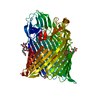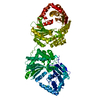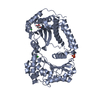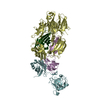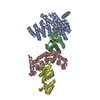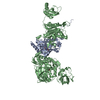+ Open data
Open data
- Basic information
Basic information
| Entry | Database: SASBDB / ID: SASDFB6 |
|---|---|
 Sample Sample | The periplasmically localised protease PqqL from Escherichia coli
|
| Function / homology |  Function and homology information Function and homology information Hydrolases; Acting on peptide bonds (peptidases); Metalloendopeptidases / Hydrolases; Acting on peptide bonds (peptidases); Metalloendopeptidases /  metalloendopeptidase activity / metalloendopeptidase activity /  metallopeptidase activity / outer membrane-bounded periplasmic space / metallopeptidase activity / outer membrane-bounded periplasmic space /  peptidase activity / peptidase activity /  proteolysis / zinc ion binding / proteolysis / zinc ion binding /  cytosol cytosolSimilarity search - Function |
| Biological species |   Escherichia coli (strain K12) (bacteria) Escherichia coli (strain K12) (bacteria) |
 Citation Citation |  Journal: PLoS Genet / Year: 2019 Journal: PLoS Genet / Year: 2019Title: Protease-associated import systems are widespread in Gram-negative bacteria. Authors: Rhys Grinter / Pok Man Leung / Lakshmi C Wijeyewickrema / Dene Littler / Simone Beckham / Robert N Pike / Daniel Walker / Chris Greening / Trevor Lithgow /   Abstract: Bacteria have evolved sophisticated uptake machineries in order to obtain the nutrients required for growth. Gram-negative plant pathogens of the genus Pectobacterium obtain iron from the protein ...Bacteria have evolved sophisticated uptake machineries in order to obtain the nutrients required for growth. Gram-negative plant pathogens of the genus Pectobacterium obtain iron from the protein ferredoxin, which is produced by their plant hosts. This iron-piracy is mediated by the ferredoxin uptake system (Fus), a gene cluster encoding proteins that transport ferredoxin into the bacterial cell and process it proteolytically. In this work we show that gene clusters related to the Fus are widespread in bacterial species. Through structural and biochemical characterisation of the distantly related Fus homologues YddB and PqqL from Escherichia coli, we show that these proteins are analogous to components of the Fus from Pectobacterium. The membrane protein YddB shares common structural features with the outer membrane ferredoxin transporter FusA, including a large extracellular substrate binding site. PqqL is an active protease with an analogous periplasmic localisation and iron-dependent expression to the ferredoxin processing protease FusC. Structural analysis demonstrates that PqqL and FusC share specific features that distinguish them from other members of the M16 protease family. Taken together, these data provide evidence that protease associated import systems analogous to the Fus are widespread in Gram-negative bacteria. |
 Contact author Contact author |
|
- Structure visualization
Structure visualization
| Structure viewer | Molecule:  Molmil Molmil Jmol/JSmol Jmol/JSmol |
|---|
- Downloads & links
Downloads & links
-Data source
| SASBDB page |  SASDFB6 SASDFB6 |
|---|
-Related structure data
- External links
External links
| Related items in Molecule of the Month |
|---|
-Models
| Model #2983 |  Type: dummy / Radius of dummy atoms: 3.50 A / Chi-square value: 0.506 / P-value: 0.003869  Search similar-shape structures of this assembly by Omokage search (details) Search similar-shape structures of this assembly by Omokage search (details) |
|---|---|
| Model #2985 |  Type: dummy / Software: (5) / Radius of dummy atoms: 3.50 A / Symmetry  : P1 / Chi-square value: 0.506 / P-value: 0.003869 : P1 / Chi-square value: 0.506 / P-value: 0.003869 Search similar-shape structures of this assembly by Omokage search (details) Search similar-shape structures of this assembly by Omokage search (details) |
| Model #2984 | 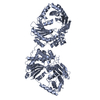 Type: atomic / Symmetry  : P1 / Chi-square value: 9.541 : P1 / Chi-square value: 9.541 Search similar-shape structures of this assembly by Omokage search (details) Search similar-shape structures of this assembly by Omokage search (details) |
- Sample
Sample
 Sample Sample | Name: The periplasmically localised protease PqqL from Escherichia coli Specimen concentration: 8 mg/ml |
|---|---|
| Buffer | Name: 20 mM Tris HCl, 150 nM NaCl, 0.02 % NaN3, 5% glycerol / pH: 7.8 |
| Entity #1638 | Type: protein / Description: Zinc protease PqqL / Formula weight: 101.744 / Num. of mol.: 1 / Source: Escherichia coli (strain K12) / References: UniProt: P31828 Sequence: AALPQDEKLI TGQLDNGLRY MIYPHAHPKD QVNLWLQIHT GSLQEEDNEL GVAHFVEHMM FNGTKTWPGN KVIETFESMG LRFGRDVNAY TSYDETVYQV SLPTTQKQNL QQVMAIFSEW SNAATFEKLE VDAERGVITE EWRAHQDAKW RTSQARRPFL LANTRNLDRE ...Sequence: AALPQDEKLI TGQLDNGLRY MIYPHAHPKD QVNLWLQIHT GSLQEEDNEL GVAHFVEHMM FNGTKTWPGN KVIETFESMG LRFGRDVNAY TSYDETVYQV SLPTTQKQNL QQVMAIFSEW SNAATFEKLE VDAERGVITE EWRAHQDAKW RTSQARRPFL LANTRNLDRE PIGLMDTVAT VTPAQLRQFY QRWYQPNNMT FIVVGDIDSK EALALIKDNL SKLPANKAAE NRVWPTKAEN HLRFNIINDK ENRVNGIALY YRLPMVQVND EQSFIEQAEW SMLVQLFNQR LQERIQSGEL KTISGGTARS VKIAPDYQSL FFRVNARDDN MQDAANALMA ELATIDQHGF SAEELDDVKS TRLTWLKNAV DQQAERDLRM LTSRLASSSL NNTPFLSPEE TYQLSKRLWQ QITVQSLAEK WQQLRKNQDA FWEQMVNNEV AAKKALSPAA ILALEKEYAN KKLAAYVFPG RNLSLTVDAD PQAEISSKET LAENLTSLTL SNGARVILAK SAGEEQKLQI IAVSNKGDLS FPAQQKSLIA LANKAVSGSG VGELSSSSLK RWSAENSVTM SSKVSGMNTL LSVSARTNNP EPGFQLINQR ITHSTINDNI WASLQNAQIQ ALKTLDQRPA EKFAQQMYET RYADDRTKLL QENQIAQFTA ADALAADRQL FSSPADITFV IVGNVAEDKL VALITRYLGS IKHSDSPLAA GKPLTRATDN ASVTVKEQNE PVAQVSQWKR YDSRTPVNLP TRMALDAFNV ALAKDLRVNI REQASGAYSV SSRLSVDPQA KDISHLLAFT CQPERHDELL TLANEVMVKR LAKGISEQEL NEYQQNVQRS LDIQQRSVQQ LANTIVNSLI QYDDPAAWTE QEQLLKQMTV ENVNTAVKQY LSHPVNTYTG VLLPK |
-Experimental information
| Beam | Instrument name: Australian Synchrotron SAXS/WAXS / City: Melbourne / 国: Australia  / Shape / Shape : Point / Type of source: X-ray synchrotron : Point / Type of source: X-ray synchrotron Synchrotron / Wavelength: 0.10322 Å / Dist. spec. to detc.: 1.426 mm Synchrotron / Wavelength: 0.10322 Å / Dist. spec. to detc.: 1.426 mm | ||||||||||||||||||||||||||||||
|---|---|---|---|---|---|---|---|---|---|---|---|---|---|---|---|---|---|---|---|---|---|---|---|---|---|---|---|---|---|---|---|
| Detector | Name: Pilatus 1M / Type: Dectris / Pixsize x: 172 mm | ||||||||||||||||||||||||||||||
| Scan | Measurement date: Jun 14, 2017 / Storage temperature: 20 °C / Cell temperature: 20 °C / Exposure time: 1 sec. / Number of frames: 10 / Unit: 1/A /
| ||||||||||||||||||||||||||||||
| Distance distribution function P(R) |
| ||||||||||||||||||||||||||||||
| Result |
|
 Movie
Movie Controller
Controller


